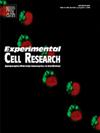Exosomal lncRNA Mir100hg derived from cancer stem cells enhance glycolysis and promote metastasis of melanoma through miR-16-5p and miR-23a-3p
IF 3.3
3区 生物学
Q3 CELL BIOLOGY
引用次数: 0
Abstract
Increasing evidence demonstrate that the significant role of long non-coding RNA (lncRNA) in metastasis and the remodeling of the tumor microenvironment. However, the precise mechanisms of lncRNAs in cancer metastasis are still poorly understood. The function of lncRNA-Mir100hg in melanoma and its involvement in mediating communication between tumor stem cells and non-stemness tumor cells remains unknown. We found that Mir100hg is upregulated in melanoma stem cells (CSCs) known as OLSD. Furthermore, Mir100hg can be transferred from OLSD to non-stem cancer cells (OL) through exosomes. Once Mir100hg enters OL cells, it operates through a competitive endogenous RNA (ceRNA) mechanism. It competes with microRNAs (miR-16-5p and miR-23a-3p) by binding to them, thus preventing these miRNAs from targeting their mRNAs. As a result, the expression of glycolysis-related mRNA was restored. This ultimately enhances the metastatic capability of OL cells. In summary, our study uncovers a network used by CSCs to transfer their high metastatic activity to non-stem cancer cells through the exosomal Mir100hg. This mechanism sheds new light on the communication between heterogeneous cancer cell populations in melanoma. Importantly, it provides novel insights into the role of lncRNAs in cancer metastasis and highlights the significance of the tumor microenvironment in facilitating metastasis.
来自癌症干细胞的外泌体 lncRNA Mir100hg 通过 miR-16-5p 和 miR-23a-3p 增强糖酵解并促进黑色素瘤的转移。
越来越多的证据表明,长非编码 RNA(lncRNA)在癌症转移和肿瘤微环境重塑中发挥着重要作用。然而,人们对 lncRNA 在癌症转移中的确切机制仍知之甚少。lncRNA-Mir100hg在黑色素瘤中的功能及其参与介导肿瘤干细胞和非干性肿瘤细胞之间的交流仍是未知数。我们发现,Mir100hg在被称为OLSD的黑色素瘤干细胞(CSCs)中上调。此外,Mir100hg可通过外泌体从OLSD转移到非干细胞癌细胞(OL)。Mir100hg 进入 OL 细胞后,会通过竞争性内源性 RNA(ceRNA)机制发挥作用。它通过与 microRNA(miR-16-5p 和 miR-23a-3p)结合来与它们竞争,从而阻止这些 miRNA 靶向它们的 mRNA。因此,糖酵解相关 mRNA 的表达得到了恢复。这最终增强了 OL 细胞的转移能力。总之,我们的研究揭示了干细胞通过外泌体 Mir100hg 将其高转移活性转移到非干癌细胞的网络。这一机制为黑色素瘤中异质癌细胞群之间的交流提供了新的线索。重要的是,它为lncRNA在癌症转移中的作用提供了新的见解,并强调了肿瘤微环境在促进转移中的重要作用。
本文章由计算机程序翻译,如有差异,请以英文原文为准。
求助全文
约1分钟内获得全文
求助全文
来源期刊

Experimental cell research
医学-细胞生物学
CiteScore
7.20
自引率
0.00%
发文量
295
审稿时长
30 days
期刊介绍:
Our scope includes but is not limited to areas such as: Chromosome biology; Chromatin and epigenetics; DNA repair; Gene regulation; Nuclear import-export; RNA processing; Non-coding RNAs; Organelle biology; The cytoskeleton; Intracellular trafficking; Cell-cell and cell-matrix interactions; Cell motility and migration; Cell proliferation; Cellular differentiation; Signal transduction; Programmed cell death.
 求助内容:
求助内容: 应助结果提醒方式:
应助结果提醒方式:


